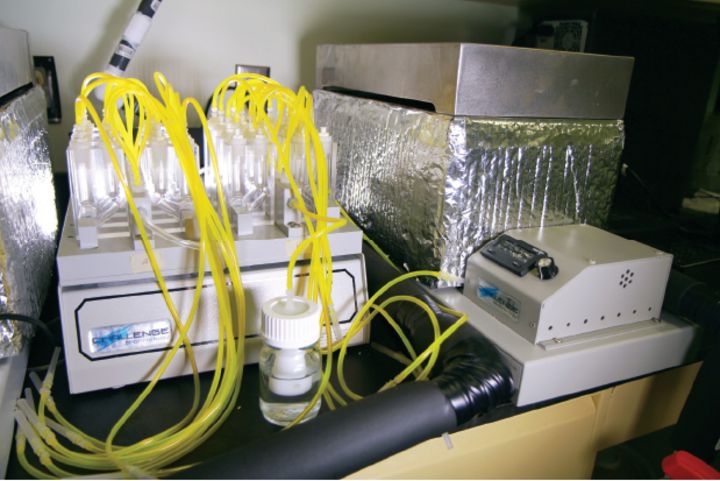• Ionic Chromatograph
• Gas and liquid chromatographs
• Mass spectrometers
• Level 2 Laboratory for Bacteria
This laboratory is used in particular to carry out research work on understanding the environmental fate of energetic materials. The laboratory consists of two experimental pans, the size of which makes it possible to carry out restoration experiments similar to field conditions, but under controlled experimental conditions. These tanks can contain 4 to 9 m3 of soil from contaminated sites or clean soils to which specific contaminants can be added.
A mass spectrometry service is offered to the scientific community for the identification of organic molecules, the analysis of natural products, the quantification of metabolites of pharmaceutical products, the analysis of trace pollutants, the determination of the molecular weight of proteins, the sequencing of peptides. The service includes, among others, a Micromass Quattro II triple quadrupole equipped with gas and liquid chromatography interfaces. It can be operated in positive and negative mode and carry out a mass scan up to 4000 m / z. The mass spectrometry service can perform a variety of MS / MS experiments such as daughter ion, parent ion and neutral fragment loss analysis. Various ionization modes such as electronic impact (EI), chemical ionization (CI), chemical ionization at atmospheric pressure (APCI), electrospray and nanospray can be used. It has an interface for gas chromatography with an HP 6890 gas chromatograph and an interface for HPLC HP 1100 liquid chromatography equipped with an automatic injector and a UV detector.

The MiCEL laboratory specializes in the molecular and metagenomic analysis of microbial communities present in water management infrastructure.
The laboratory is capable of performing various analyses using DNA and RNA present in environmental samples including: PCR (polymerase chain reaction) analysis and quantification, in situ fluorescence microscopy Hybridization of 16S RNA (FISH), high throughput amplicon sequencing to analyze phylogenetic and functional diversity of communities, and metagenomic sequencing (shotgun sequencing).
///Features :
- Filtration system with three ceramic membrane chambers measuring 110 cm in length by 2.5 cm in diameter (microfiltration and ultrafiltration)
- Filtration capacity of 150 L to 200 L per hour; 600 L double walled tank connected to a cooling system
- Pre-filter; Pump with a maximum operating capacity of 3500 rpm (8 horse power).
/// Samples :
- Liquids (effluents, residual liquids, fluids, liquid waste, liquids resulting from chemical processes, and so on)
- Capacity to process samples of up to 1 000 L.
/// Examples of applications :
- Industrial effluent treatment; Molecule separation, concentration, and purification (organic or inorganic)
- Recycling of harmful biomass
- Extraction of recyclable organic compounds
- Recycling of waste products (polyethylene glycol, cutting fluids, essential oils, etc.)
- Separation of nanoparticles from dissolved salts in order to characterize the nanoparticle content - Nanoparticle and other nanomaterial concentration.

/// Module intended for the validation of the choice of suitable biomass for the treatment of a given wastewater. This unit is equipped with:
- Air diffusers
- Waste water metering pump
- pH and dissolved oxygen probes
- Temperature sensor.

/// Features
- Forthcoming
/// Features:
- Pumps with a capacity of 12 to 20 gallons per minute
- 50 gallon/minute recirculation pumps
- 7.5 horsepower (3500 rpm) pumps
- Spiral-wound membrane chamber (measuring 40 inches in length by 8 inches in diameter)
- Filtration capacity of 600 L per hour
- 100 to 1 000-litre tank
- Prefilters
/// Samples:
- Liquids (effluents, residual liquids, fluids, liquid waste, liquids generated by chemical processes, etc.)
- Capacity to treat liquids by micro-, ultra-, nanofiltration, and reverse osmosis
/// Examples of applications:
- Separation of nanoparticles from dissolved salts in order to characterize the nanoparticle content
- Nanoparticle or other nanomaterial concentration
- Purification of industrial effluents
- Separation, concentration, and purification of molecules (organic or inorganic)
/// Other test benches available:
- Two filtration systems with 2 spiral-wound membrane chambers measuring 8 inches in diameter
- A filtration system with a spiral-wound membrane measuring 4 inches in diameter
- A filtration system with a spiral-wound membrane measuring 2 inches in diameter

The service is able to meet several needs in the animal, plant or microbial fields, including:
• Research and identification of viruses from all sources;
• Research and identification (Gram-positive or Gram-negative) and description of bacteria from all sources
• Research and identification of contaminants (eg mycoplasma) in clinical specimens or cell cultures
• Immunoelectromicroscopy with or without colloidal gold on a liquid sample (negative staining) or on cell sections (pre- or post-embedding techniques)
• Quality control of viral fractions of density gradients
• Cell morphology on thin sections
• Quantification of viruses (eg Retrovirus) using latex spheres of known concentration by negative staining.
• Quality control of biological products released to municipal sewage
• Research of Retrovirus in cells, identification and count of the proportion of infected cells (cell sections)
These laboratories make it possible to analyze water samples by colorimetry, fluorometry, spectroscopy, radioisotopy and chromatography, as well as to analyze organic compounds and trace metals present in different matrices (water, effluents, sewage sludge, soils, sediments, biological tissues), and finally, to analyze the elements present in solid samples (rocks, soils, sediments, sludge). X-ray microfluorescence scanning: Non-destructive x-ray analyzes coupled with chemical X-ray fluorescence analysis of rocks, soils and sediments. Scanning electron microscopy: Production of high resolution images of the surface and composition of a sample using technology using electron-matter interactions.